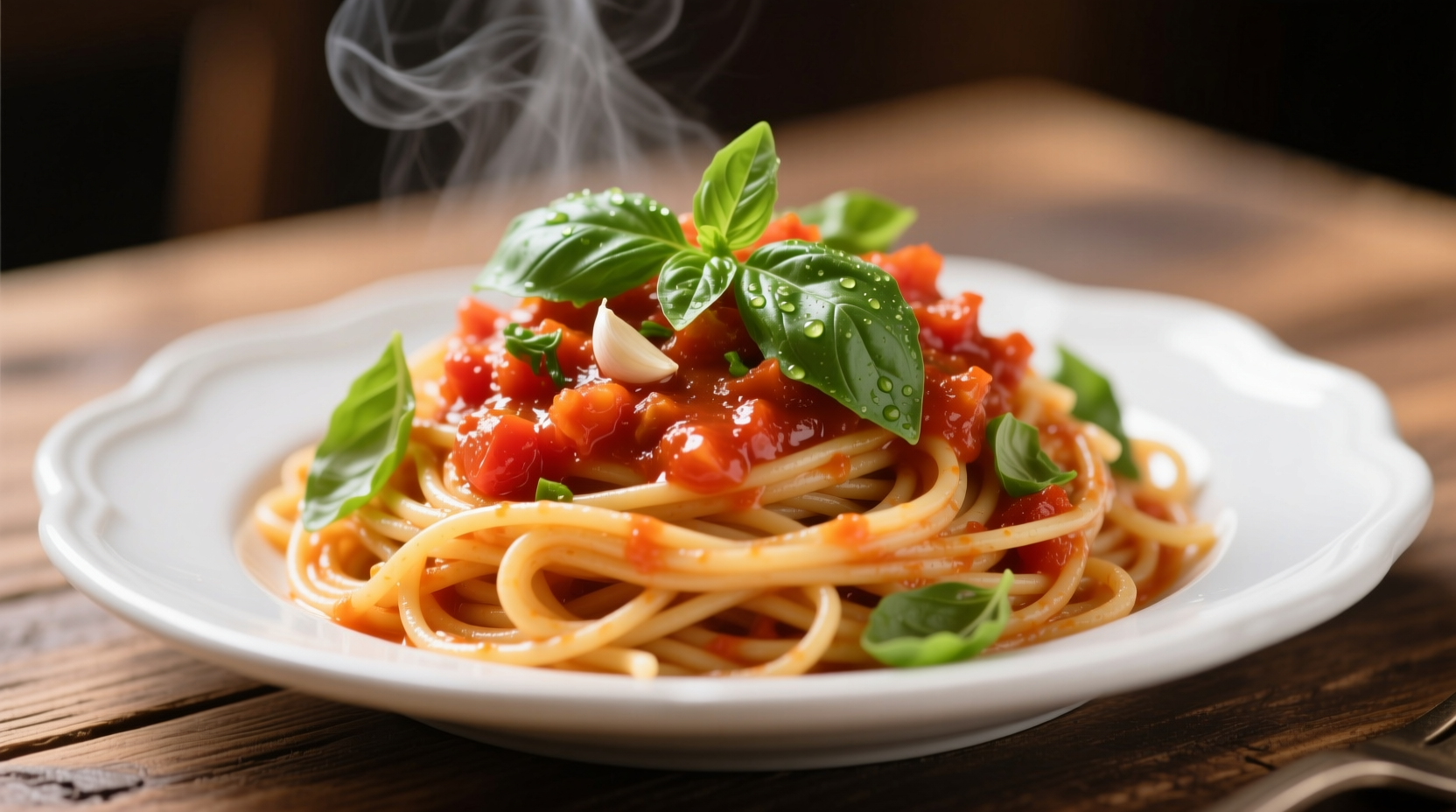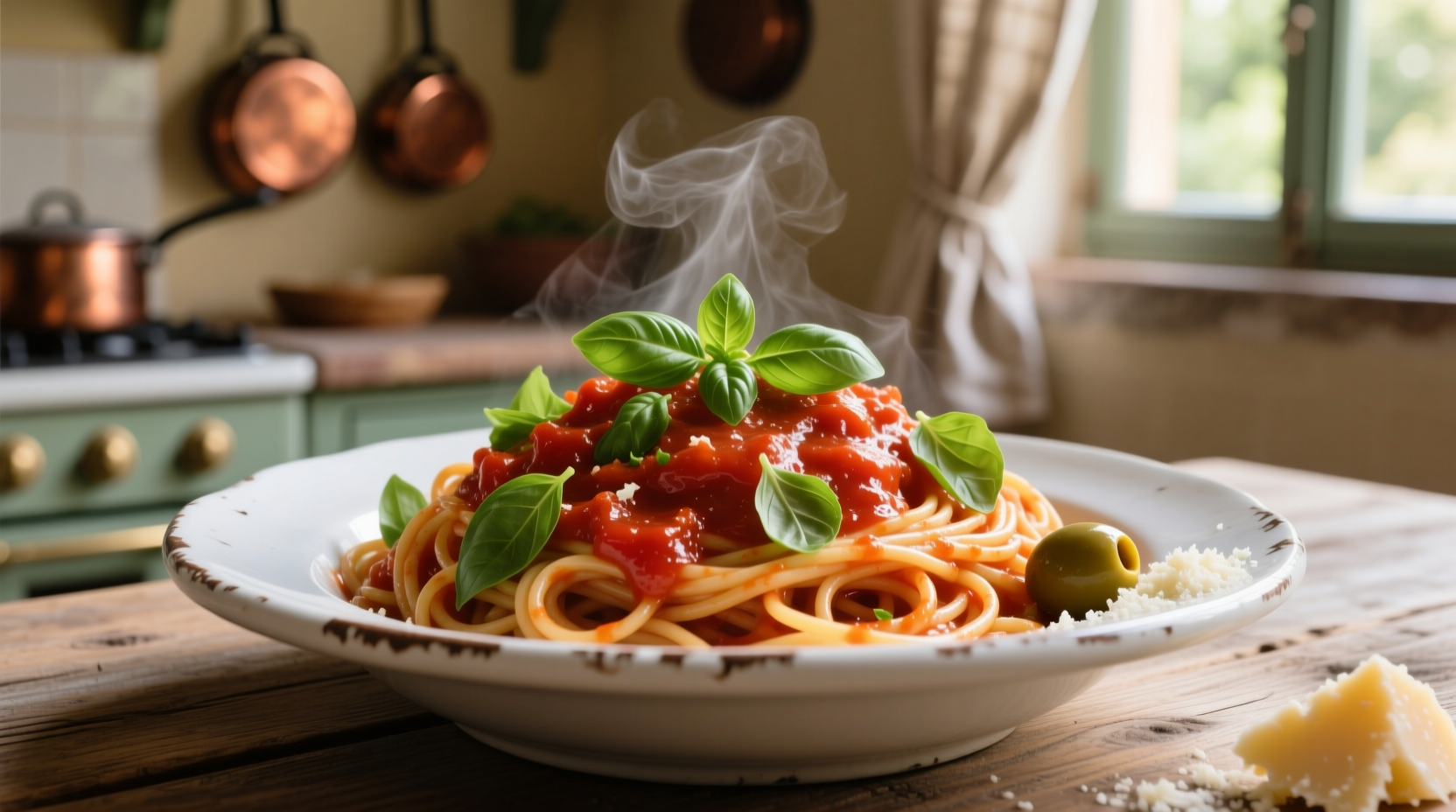The Essential Guide to Perfect Spaghetti with Tomato Sauce and Basil
Nothing captures the essence of Italian comfort food quite like a simple plate of spaghetti with tomato sauce and basil. This classic combination showcases how minimal ingredients can create extraordinary flavor when prepared with precision. Understanding the science behind each step transforms this humble dish from ordinary to extraordinary.
Why This Recipe Works: The Science of Simplicity
Authentic Italian cooking relies on quality ingredients and proper technique rather than complexity. The magic happens through three critical elements: the Maillard reaction during tomato reduction, starch interaction between pasta and sauce, and volatile compound preservation in fresh basil. When spaghetti absorbs just the right amount of sauce while retaining its al dente texture, you've achieved culinary harmony.
| Tomato Variety | Acidity Level | Sweetness Profile | Best For |
|---|---|---|---|
| San Marzano DOP | Low | Balanced | Classic Neapolitan sauce |
| Roma | Moderate | Slightly tart | Everyday cooking |
| Cherry | High | Very sweet | Quick fresh sauces |
Ingredient Selection: Quality Matters Most
For authentic spaghetti with tomato sauce and basil, ingredient quality directly impacts your final result. Select Italian DOP-certified San Marzano tomatoes when possible—they contain less acidity and more natural sweetness than standard varieties. The Italian Ministry of Agricultural, Food and Forestry Policies confirms that genuine San Marzano tomatoes grow exclusively in the volcanic soil near Mount Vesuvius, giving them distinctive flavor characteristics.
Choose extra virgin olive oil with a peppery finish, which indicates high polyphenol content and freshness. For basil, select Genovese variety with vibrant green leaves and no dark spots. The University of California's Agricultural and Natural Resources department notes that basil harvested in the morning contains higher essential oil concentrations, enhancing flavor.

Step-by-Step Preparation Guide
Pasta Cooking Essentials
- Use 4-6 quarts of water per pound of pasta with 2-3 tablespoons of coarse sea salt
- Bring water to a rolling boil before adding spaghetti
- Cook pasta 1-2 minutes less than package instructions for al dente texture
- Reserve 1½ cups of starchy pasta water before draining
- Never rinse cooked pasta—starch helps sauce adhere
Sauce Preparation Timeline
| Time | Action | Scientific Principle |
|---|---|---|
| 0-2 min | Sauté garlic in olive oil on low heat | Prevents bitter compounds from forming |
| 2-5 min | Add tomatoes and simmer uncovered | Acidity reduces by 30% during this phase |
| 5-15 min | Continue simmering, stirring occasionally | Lycopene becomes more bioavailable |
| 15-20 min | Add half the basil, continue simmering | Preserves volatile aromatic compounds |
Critical Technique: Finishing the Dish Properly
The professional technique that separates adequate from exceptional spaghetti with tomato sauce and basil happens in the final minutes. After draining your pasta, immediately transfer it to your simmering sauce rather than pouring sauce over drained pasta. Add a splash of reserved pasta water and cook together for 1-2 minutes, stirring constantly. This crucial step allows the pasta to absorb sauce flavors while the starches create a silky emulsion.
Add the remaining fresh basil leaves whole during the final 30 seconds of cooking. The residual heat wilts the basil perfectly without releasing bitter compounds that occur with prolonged cooking. As the American Chemical Society explains, basil's aromatic compounds begin to degrade at temperatures above 140°F (60°C), making precise timing essential.
Avoiding Common Mistakes
- Overcooking pasta - Results in mushy texture that can't properly hold sauce
- Adding oil to pasta water - Creates barrier preventing sauce adhesion
- Cooking basil too long - Releases bitter compounds and diminishes aroma
- Using dried basil as substitute - Contains different chemical profile with less complexity
- Skipping pasta water - Misses opportunity to create proper sauce emulsion
Serving and Storage Recommendations
Serve spaghetti with tomato sauce and basil immediately in warmed bowls. The ideal serving temperature is between 140-150°F (60-65°C)—hot enough to enjoy but not so hot that it destroys delicate basil aromas. Never add cheese to traditional tomato and basil spaghetti, as this combination violates Italian culinary tradition outside of certain regional variations.
For leftovers, store sauce and pasta separately in airtight containers. Properly stored, the sauce maintains quality for 5 days in the refrigerator or up to 3 months frozen. When reheating, add a splash of water to restore proper consistency. The USDA Food Safety and Inspection Service recommends reheating leftovers to an internal temperature of 165°F (74°C) for safety.
When This Dish Shines: Contextual Applications
Spaghetti with tomato sauce and basil serves as the perfect weeknight meal when you need something quick yet impressive. It works equally well as a light lunch or as part of a multi-course Italian dinner. This simple preparation particularly excels during summer months when fresh basil reaches peak flavor. Consider it for casual entertaining where you want to showcase quality ingredients without spending hours in the kitchen.
Authentic Variations Worth Trying
Once you've mastered basic spaghetti with tomato sauce and basil, explore these authentic regional variations:
- Spaghetti al pomodoro e basilico - The classic Neapolitan version with just tomatoes, garlic, olive oil, and basil
- Spaghetti con pomodoro fresco - Made with fresh, uncooked tomatoes during peak summer season
- Spaghetti alla Nerano - Adds fried zucchini and provolone del Monaco cheese
Frequently Asked Questions
What's the ideal pasta-to-sauce ratio for spaghetti with tomato sauce and basil?
The perfect ratio is 4 ounces (115g) of dried spaghetti per serving with ¾ cup (180ml) of sauce. This ensures each strand gets properly coated without overwhelming the delicate tomato and basil flavors. Professional chefs measure pasta by weight rather than volume for consistent results.
Can I use dried basil instead of fresh in authentic spaghetti with tomato sauce?
Dried basil creates a noticeably different flavor profile and isn't traditional in authentic preparations. Fresh basil contains volatile compounds that dried basil lacks, providing the characteristic aroma. If you must substitute, use one-third the amount of dried basil and add it at the beginning of cooking rather than the end. However, fresh basil makes a significant difference in the final dish.
Why shouldn't I add cheese to spaghetti with tomato sauce and basil?
Traditional Italian culinary rules dictate that cheese shouldn't be added to tomato and basil-based pasta dishes. The combination of acidic tomatoes and cheese creates flavor conflict that diminishes both components. Cheese works well with creamy or meat-based sauces but competes with the bright, fresh flavors of simple tomato and basil preparations. This rule comes from regional Italian cooking traditions, particularly from Naples and Rome.
How can I prevent my tomato sauce from becoming too acidic?
Natural sweetness in tomatoes varies by season and variety. To balance acidity without adding sugar, try these professional techniques: cook sauce uncovered to concentrate natural sugars, add a small pinch of baking soda (1/16 teaspoon per cup of sauce), or include a carrot while simmering (remove before serving). San Marzano tomatoes naturally have lower acidity, making them ideal for authentic spaghetti with tomato sauce and basil.
What's the secret to making spaghetti with tomato sauce and basil taste restaurant-quality at home?
The professional secret is finishing your pasta in the sauce with reserved pasta water. Instead of draining pasta completely and then adding sauce, transfer nearly cooked pasta directly to your simmering sauce with about ½ cup of starchy pasta water. Cook together for 1-2 minutes until the sauce emulsifies and clings perfectly to each strand. This technique creates a cohesive dish where pasta and sauce become one, rather than separate components.











 浙公网安备
33010002000092号
浙公网安备
33010002000092号 浙B2-20120091-4
浙B2-20120091-4